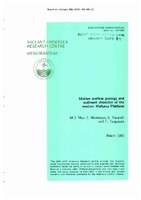| dc.contributor.author | Max, Michael D. | |
| dc.contributor.author | Michelozzi, Enzo | |
| dc.contributor.author | Tonarelli, Briano | |
| dc.contributor.author | Turgutcan, Ferda | |
| dc.date.accessioned | 2018-10-11T14:06:22Z | |
| dc.date.available | 2018-10-11T14:06:22Z | |
| dc.date.issued | 1995/03 | |
| dc.identifier | 1769 | |
| dc.identifier.govdoc | SM-286 | |
| dc.identifier.uri | http://hdl.handle.net/20.500.12489/232 | |
| dc.description.abstract | A site survey of the seabottom west of Mallorca in the central Balearic Islands has characterized the bottom and the immediate sub-bottom. High resolution seismic reflection Uniboom, deeper penetrating (about 5x Uniboom) reflection seismic Sparker, and side-scan sonargram surveys have been completed concurrent to high resolution bathymetry that is stored in digital form. All surveys were controlled by GPS. In addition, both core and grab samples have been recovered and analyzed. The shelf area is composed of a flat surface eroded into hard rocks on which it was difficult to image subjacent sedimentary bedding. The acoustic basement of the southern and central area consist of acoustically 'massive' rock while the northern part of the area has acoustic basement formed from weakly bedded sedimentary rocks. The boundary between the two basements is transitional of unknown nature. A NNE-SSW trending sedimentary basin in the northern part of the area is founded on the bedded acoustic basement. A thin veneer of recent sediment overlies both types of acoustic basement and the flat-lying well-bedded sediments in the sedimentary basin. This recent sediment smoothes the nearly flat erosional surface by filling low-lying depressions in the erosional surface. It is dominantly calcareous sand formed from shell hash and minor calcareous algae, with coarse sand to fine gravel admixture of sub-rounded quartzofeldspathic material, presumably sourced from the upstanding land masses and | |
| dc.description.abstract | possibly from erosion of the shelves. At the outer edge of the shelf 10-18 m of sediments deposited since the last rise of sea level (post-Flandrian) unconformably overlies strongly bedded consolidated and semi-consolidated sediment that everywhere dip down slope. The bottom is everywhere highly reflective to acoustic energy. It is almost flat, although where acoustic basement is exposed occasional pinnacles may rarely rise to a little over 3 m above the surrounding seafloor. The main areas of exposed rock are in the far south of the area, and in a slightly upstanding rocky bottom lying to the south of the sedimentary basin. Patches of more reflective bottom surround some rocky areas. The reflective character of the sediment is probably due to the presence of more coarse shell near the rocks, which would act as a habitat for live shelly fauna. Lighter reflecting patches of sediment are less reflective and probably indicate a finer-grained composition to the sediment. | |
| dc.format | 287 p. : ill. ; 38 fig. | |
| dc.language | English | |
| dc.publisher | NATO. SACLANTCEN | |
| dc.subject | Seafloor sediments | |
| dc.subject | Marine geology | |
| dc.subject | Balearic Islands | |
| dc.subject | Seafloor | |
| dc.title | Shallow seafloor geology and sediment character ofthe western Mallorca Platform | |
| dc.type | Scientific Memorandum (SM) | |
